If you feel the number of transfer between the Premier League clubs is increasing, it is not difficult to understand that.
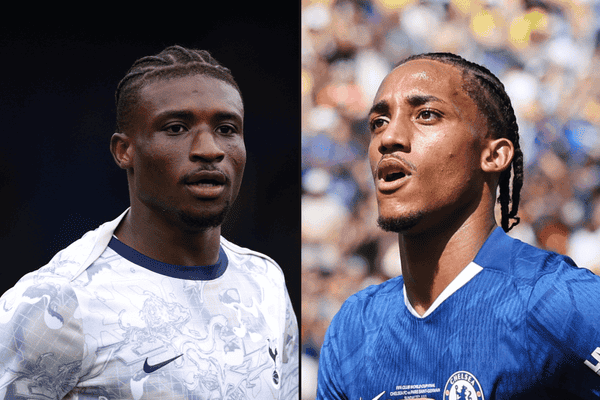 |
This summer, there were quite a few players in the Premier League moving to another club also belonging to the highest tournament in England. However, the feeling that internal deals between the Premier League teams are increasing is actually just an illusion.
Up to the time of this article was done, such deals accounted for only 25% of the total number of new contracts in the Premier League (excluding loan contracts) in the current transfer period. This figure is equal to the lowest rate in the last 5 summer.
However, the aforementioned feeling may originate from the stature of remarkable contracts.
Noni Madueke moved from Chelsea to Arsenal, Bryan Mbeumo and Matheus Cuha to join Manchester United from Brentford and Wolverhampton Wanderers, and Newcastle United recruited Anthony Elanga from Nottingham Forest.
Meanwhile, Tottenham Hotspur recruited Mohammed Kudus from West Ham United, and Chelsea added Brighton & Hove Albion and Liam Delap from Ipswich Town into his squad.
The deals to the traditional “Big Six” group of the Premier League always create the most echo. In addition to the names, contracts like Milos Kerkez to Liverpool, Rayan Ait-Touri joined Manchester City and Christian Norgaard to Arsenal to strengthen another theory: rich teams in the Premier League are collecting talents from all positions on the rankings.
Although the transfer rate between the Premier League teams is now lower than the usual medium, most of these deals are the contracts of the “Big Six” group with the remaining teams in the tournament.
The concept of “Big Six” in this context refers to the richest clubs since 2010: Arsenal, Liverpool, Manchester United and Chelsea with Manchester City, the team bought by Abu Dhabi United Group in 2008, and Tottenham Hotspur, the first team benefited from the Champions League in 2010.
In the summer transfer window this year, up to 39% of the deals between the Premier League teams are the teams of the “Big Six” group to buy players from the remaining clubs in the tournament, the highest rate since 2010.
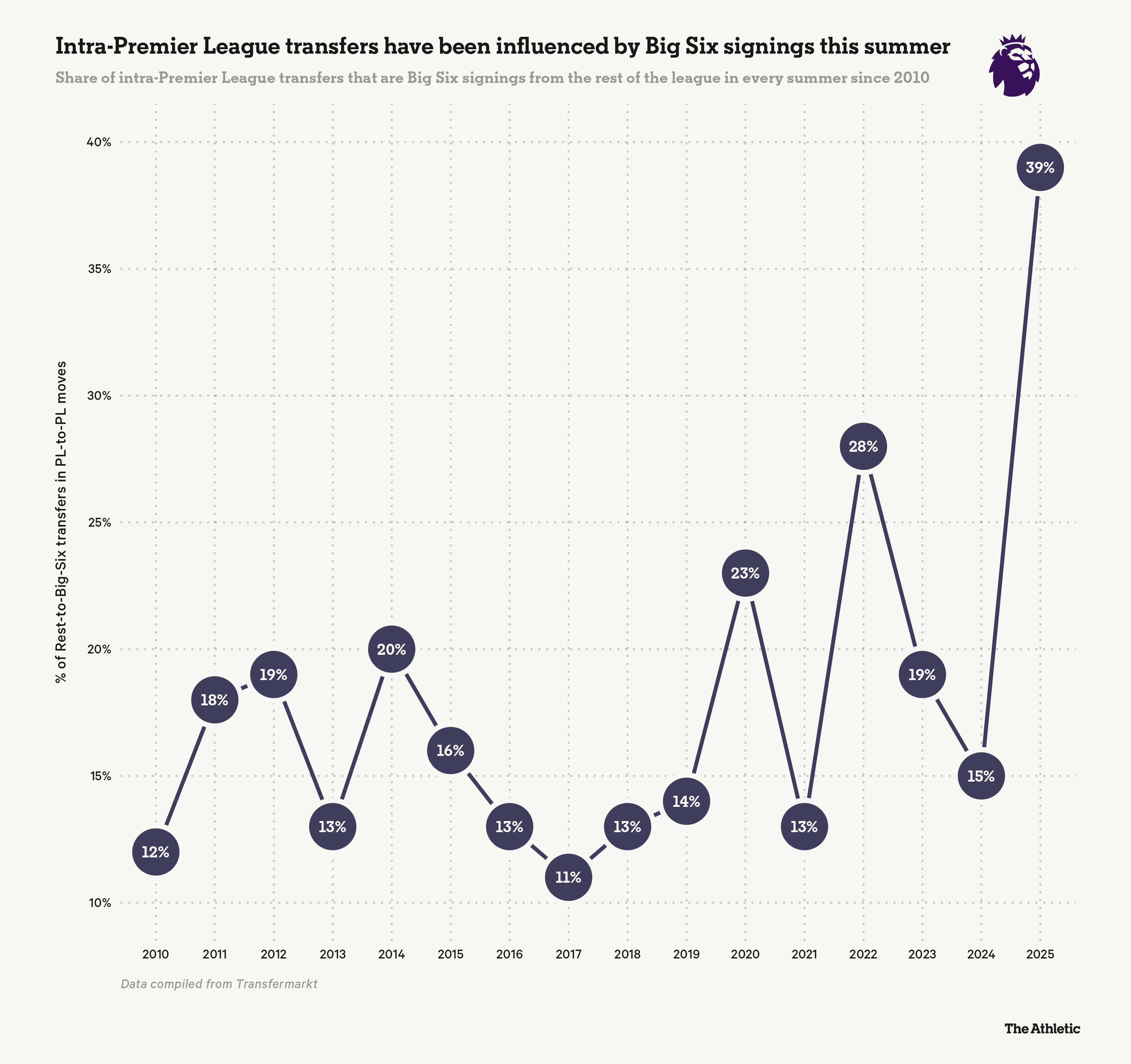 |
The trend above is not merely because the clubs of the “Big Six” group are buying more players than before.
In the period from 2015 to 2019, Arsenal, Manchester United, Liverpool, Tottenham, Chelsea and Manchester City mainly focus on recruiting talents from abroad. The ratio of summer contracts (excluding loan) from the rest of the Premier League has never exceeded 15%.
Businesses such as Kevin de Bruyne, Mohamed Salah, Son Heung-Min, William Saliba or Jorginho have proven the value worthy of the money. At that time, young talents in European teams were often more attractive and potential than the players from the “Big Six” clubs in the Premier League.
However, this is gradually changing in recent years, as big teams have gone more and more focused on recruiting players right in the tournament. In the summer of this year, 27% of the contracts of the “Big Six” group come from the remaining teams in the Premier League- the highest rate since 2010.
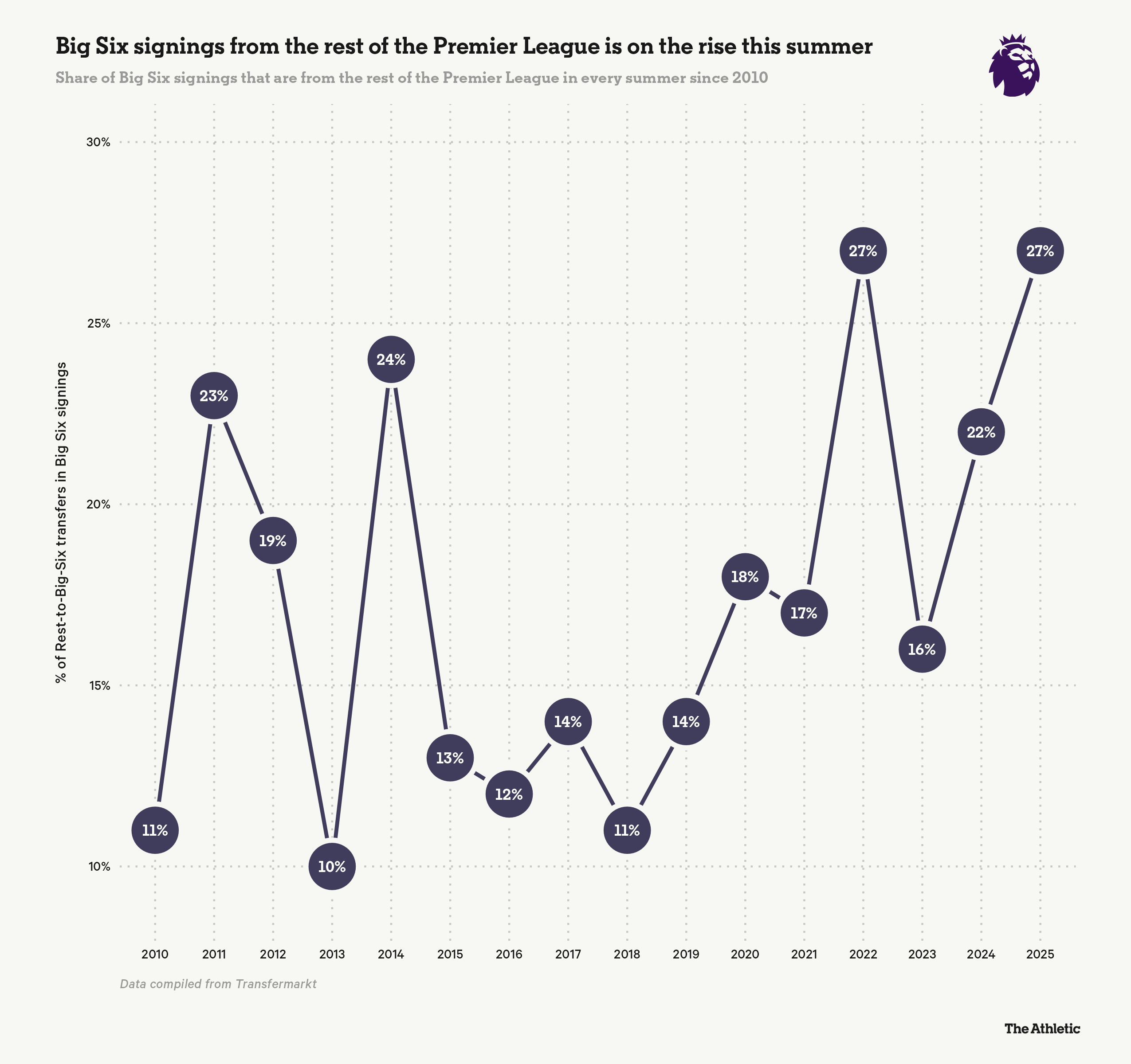 |
The teams of the “Big Six” group of the Premier League are increasingly recruiting more players from the rest of the tournament, and there are a few reasons behind this trend.
The Premier League's implementation of the Elite Player Performance Plan (EPPP) in 2012 contributed to improving the quality of young training furnaces in the UK. “We need a marked transition,” Neil Saunders – Football Director of the Premier League, who used to manage the Academy program when the EPPP was introduced and shared with The Athletic in June.
“EPPP was born in the context that the British players as well as adults from our training system do not have good technical background and sharp tactical thinking with some colleagues from Europe.”
The Liam Delap deals from Ipswich to Chelsea followed the transfer series of “homegrown” talents developed, such as Dominic Solanke leaving Bournemouth to Tottenham last summer, or Declan Rice leaving West Ham to join Arsenal in 2023. All showed the internal talents are gradually landing in big teams.
The strong spending ability of the teams of the “Big Six” team is the next factor that leads to this trend: the superior financial power of the Premier League.
According to UEFA's latest annual report named European Club Finance and Investment Landscapebased on the audited financial statements of the top 2023 of the top 745 clubs at 55 UEFA members, the total revenue of the Premier League reached 7.1 billion euros, nearly equal to the total revenue of the two tournaments, La Liga and Bundesliga combined.
Therefore, young talents at non -“Big Six” clubs tend to stay in the Premier League, where the richest teams can offer a higher transfer fee and more attractive remuneration. The gap in TV revenue is also an important part of this problem, with the latest Premier League domestic television copyright contract for the 2025/2026 period with a total value of up to £ 6.7 billion.
TV revenue explosion since the 2016/2019 cycle with £ 5.1 billion comes from domestic copyright, compared to 3 billion pounds in the previous three -year cycle, promoting the purchasing power of teams and allowing clubs outside “Big Six” to expand operations to European markets, with deals like Youi Tielemans (from Monaco to Leicester City in 2019) or Amadou inana (from Lille to Everton in 2022).
During the three consecutive summer (2016, 2017 and 2018) corresponding to the growth cycle, the percentage of contracts from outside the United Kingdom and Ireland for clubs outside “Big Six” has increased to 51%. This ratio then decreased to 46% in the period of 2019/2022, before returning 51% in the 2022/2025 cycle.
Since 2016, teams outside “Big Six” have been constantly recruiting players from the top European tournaments, led by France with 72 players to the Premier League, followed by Spain (60), Germany (59) and Italy (43).
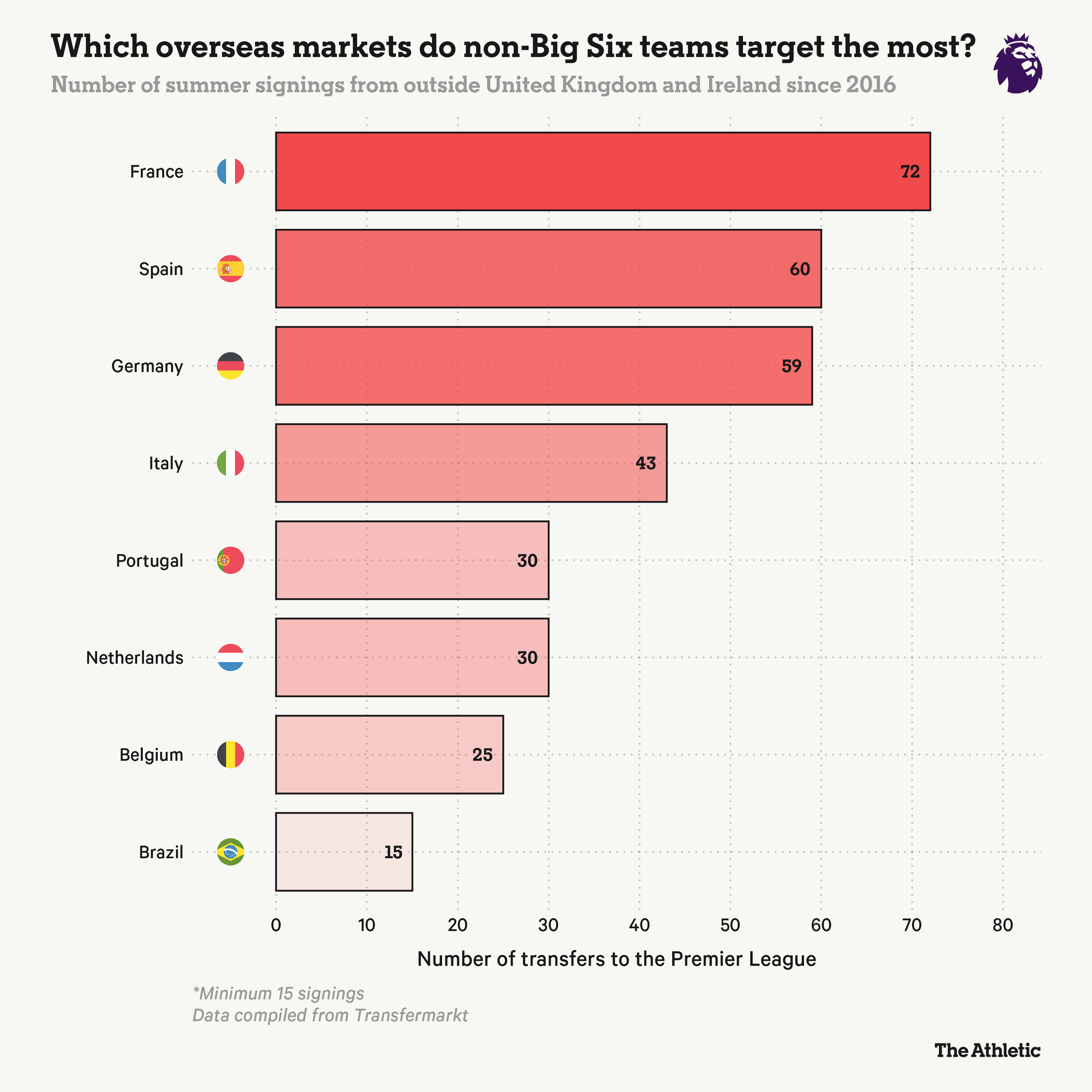 |
The search for talents from the second division in Europe can bring results, but in fact, clubs outside the “Big Six” group in the Premier League mainly recruit directly from top tournaments such as Serie A, Bundesliga, La Liga and Ligue 1, these four tournaments account for 51% of their summer contracts since 2016.
Wolverhampton Wanderers signed a contract to borrow Maheus Cuha from Atletico Madrid with the term of purchase in the summer of 2023, before selling the striker to Manchester United in June 2025. Another example was Marc Cucurella, who joined Brighton from Getafe in the summer of 2021, and was bought by Chelsea only a year later.
In addition, clubs with the lowest average age in the contracts (calculated by transfer value) since 2016 are Brighton and Brentford. These two teams aims to discover young talents rich in many different markets, and then sell it to the bigger teams in the same tournament.
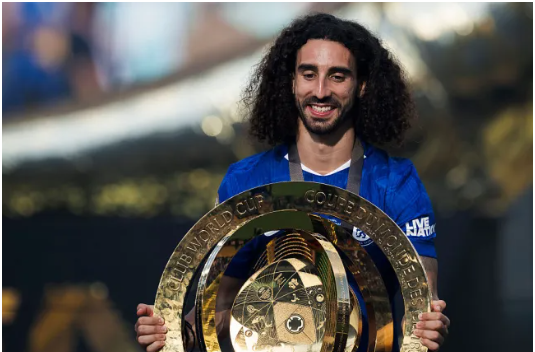 |
The list of notable Brighton's contracts is quite long, including Joao Pedro and Cucurella, along with Yves Bissouma, Moises Caicedo and Alexis Mac Allister, although the last two names are winter deals. Meanwhile, Brentford can be proud of wise contracts like David Raya and Bryan Mbeumo.
In terms of the ratio of summer contracts from abroad (excluding loan) since 2016, Brighton has only ranked third with 74% of the players from outside the United Kingdom and Ireland.
Ranked on them is Leeds United with 75%, the team has recruited 6 players from foreign markets this summer. Leaded by Wolverhampton Wanderers with 81%, the club has focused on recruiting the Portuguese player since promoting the Premier League in 2018.
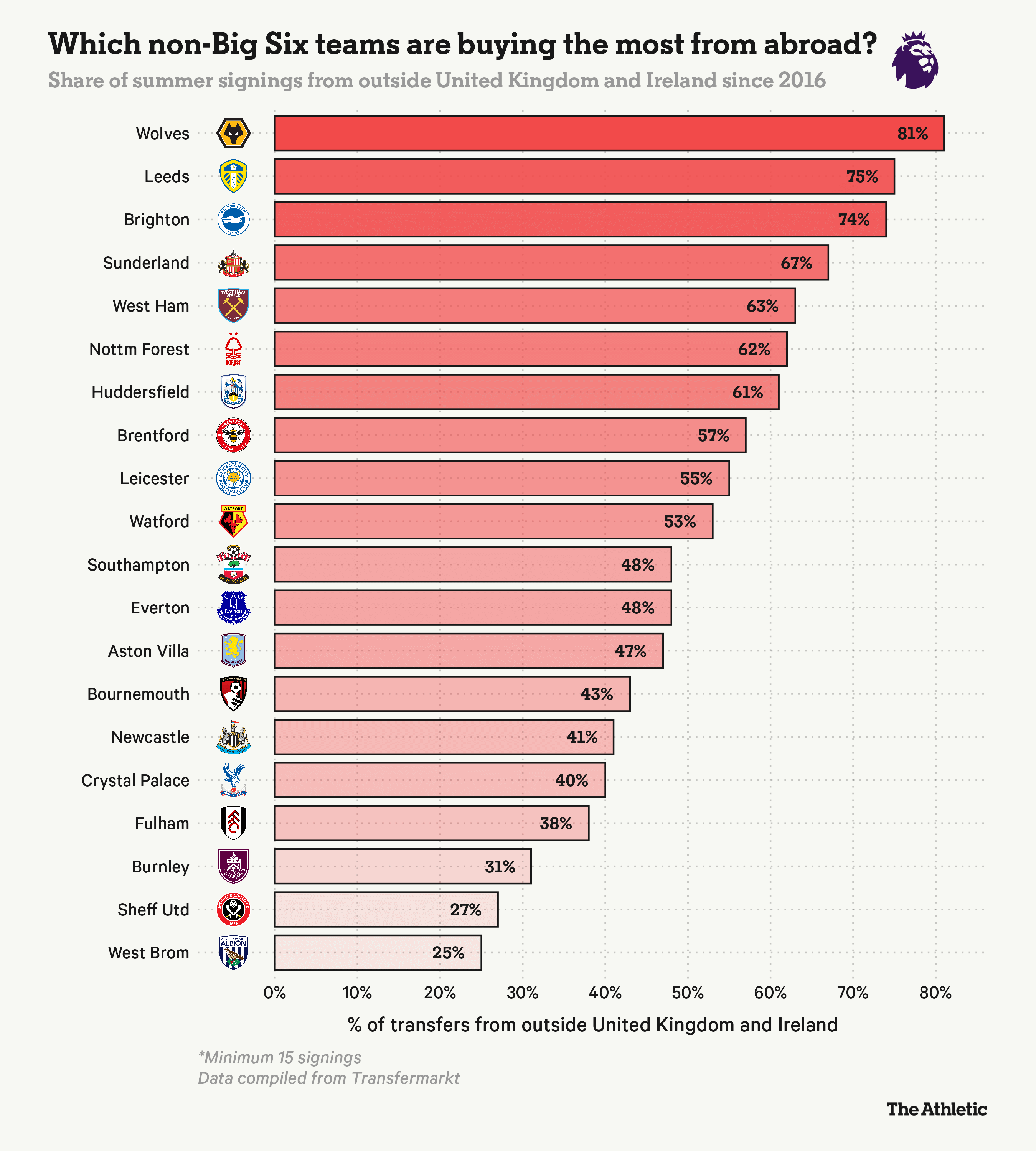 |
The players who join the clubs outside the “Big Six” group are increasingly often have special provisions in the contract, allowing bigger teams to recruit them at a certain price, whether it is a term of contract release or discount terms when the team is relegated.
Even if the fee is quite high, with the financial potential of the “Big Six” group, they can fully meet the requirements. Instead of searching for a cheaper player in unprocessed markets, these big teams have the advantage of being able to pay the “expensive fee in the Premier League” in exchange for a player who has proven its ability in the tournament and adapted well with the living environment in the UK.
“You follow Matheus (Cunha) to play weekly, seeing him causing difficulties for the opponents you will encounter,” Manchester United, Ruben Amorim's coach, shared last month. “That makes you more certainty when choosing a player.”
The fact that football institutes in the UK trained better quality players, plus the capabilities of the clubs outside “Big Six” in attracting talents from abroad, has turned the Premier League into the ideal market for the richest teams.
Summer 2025 is the harvest in the Premier League.
According to The Athletic
